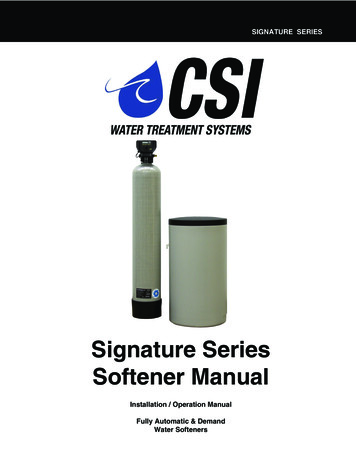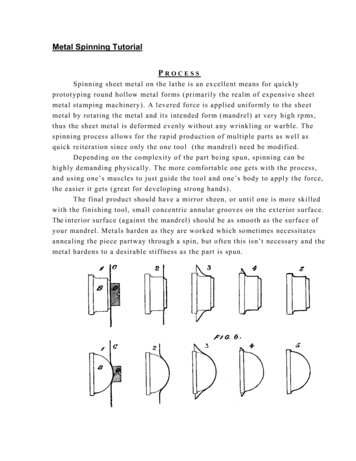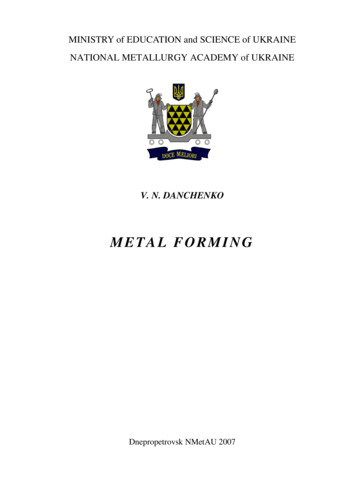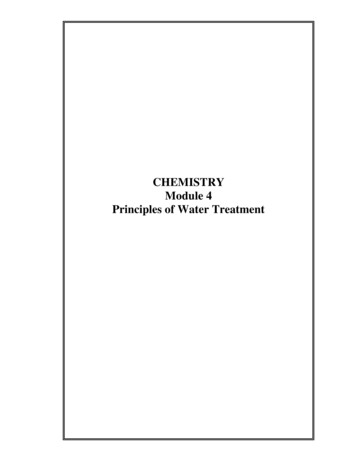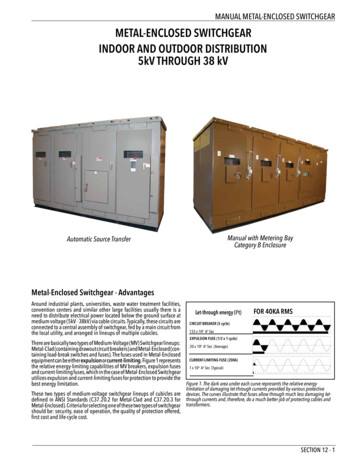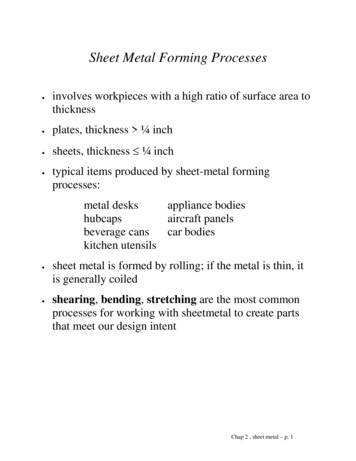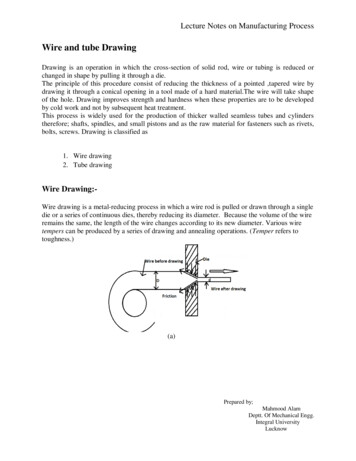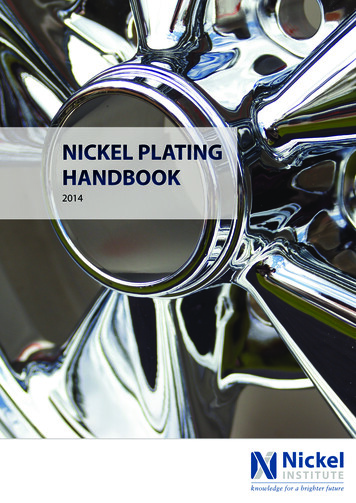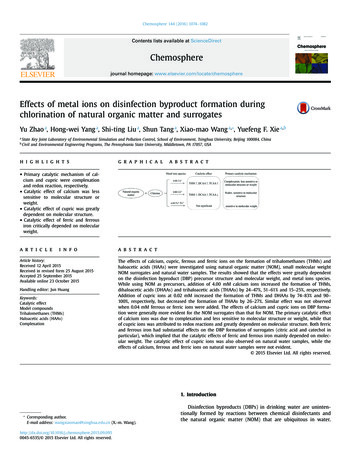
Transcription
Chemosphere 144 (2016) 1074–1082Contents lists available at ScienceDirectChemospherejournal homepage: www.elsevier.com/locate/chemosphereEffects of metal ions on disinfection byproduct formation duringchlorination of natural organic matter and surrogatesYu Zhao a, Hong-wei Yang a, Shi-ting Liu a, Shun Tang a, Xiao-mao Wang a, , Yuefeng F. Xie a,babState Key Joint Laboratory of Environmental Simulation and Pollution Control, School of Environment, Tsinghua University, Beijing 100084, ChinaCivil and Environmental Engineering Programs, The Pennsylvania State University, Middletown, PA 17057, USAh i g h l i g h t sg r a p h i c a la b s t r a c t Primary catalytic mechanism of calcium and cupric were complexationand redox reaction, respectively. Catalytic effect of calcium was lesssensitive to molecular structure orweight. Catalytic effect of cupric was greatlydependent on molecular structure. Catalytic effect of ferric and ferrousiron critically depended on molecularweight.a r t i c l ei n f oArticle history:Received 12 April 2015Received in revised form 25 August 2015Accepted 25 September 2015Available online 23 October 2015Handling editor: Jun HuangKeywords:Catalytic effectModel compoundsTrihalomethanes (THMs)Haloacetic acids (HAAs)Complexationa b s t r a c tThe effects of calcium, cupric, ferrous and ferric ions on the formation of trihalomethanes (THMs) andhaloacetic acids (HAAs) were investigated using natural organic matter (NOM), small molecular weightNOM surrogates and natural water samples. The results showed that the effects were greatly dependenton the disinfection byproduct (DBP) precursor structure and molecular weight, and metal ions species.While using NOM as precursors, addition of 4.00 mM calcium ions increased the formation of THMs,dihaloacetic acids (DHAAs) and trihaloacetic acids (THAAs) by 24–47%, 51–61% and 15–25%, respectively.Addition of cupric ions at 0.02 mM increased the formation of THMs and DHAAs by 74–83% and 90–100%, respectively, but decreased the formation of THAAs by 26–27%. Similar effect was not observedwhen 0.04 mM ferrous or ferric ions were added. The effects of calcium and cupric ions on DBP formation were generally more evident for the NOM surrogates than that for NOM. The primary catalytic effectof calcium ions was due to complexation and less sensitive to molecular structure or weight, while thatof cupric ions was attributed to redox reactions and greatly dependent on molecular structure. Both ferricand ferrous iron had substantial effects on the DBP formation of surrogates (citric acid and catechol inparticular), which implied that the catalytic effects of ferric and ferrous iron mainly depended on molecular weight. The catalytic effect of cupric ions was also observed on natural water samples, while theeffects of calcium, ferrous and ferric ions on natural water samples were not evident. 2015 Elsevier Ltd. All rights reserved.1. Introduction Corresponding author.E-mail address: wangxiaomao@tsinghua.edu.cn (X.-m. .09.0950045-6535/ 2015 Elsevier Ltd. All rights reserved.Disinfection byproducts (DBPs) in drinking water are unintentionally formed by reactions between chemical disinfectants andthe natural organic matter (NOM) that are ubiquitous in water.
Y. Zhao et al. / Chemosphere 144 (2016) 1074–1082DBPs are a very complex mixture, which include 600 identified species and much more species that are yet to be identified(Krasner et al., 2006; Bond et al., 2012). Many DBPs (e.g. halobenzoquinones) have been associated with various human cancersand reproductive complications (Hrudey and Charrois, 2012). Trihalomethanes (THMs) and haloacetic acids (HAAs) are among thefew DBPs currently regulated around the world (Wang et al., 2015)partly because they are usually the two predominant DBP groupsby mass and molarity and can to some extent represent the total DBP content, and partly because both THMs and HAAs are theprimary decomposition end-products of many unstable and potentially more toxic intermediate DBPs (Zhai and Zhang, 2011; Bondet al., 2012). The formation and control of THMs and HAAs havebeen investigated in many studies (Westerhoff et al., 2004; Reckhow et al., 2004; Hua and Reckhow, 2007; Liu et al., 2008). Because of the complex chemical composition and molecular structure of NOM (Kornegay et al., 2000; Sutton and Sposito, 2005),simple organic compounds are usually used as NOM surrogates todetermine the mechanisms of DBP formation (Boyce and Hornig,1983; Chang et al., 2006; Bond et al., 2009; Zeng and Arnold, 2013;Hua et al., 2014). Previous studies have suggested that activatedaromatics, amines and β -dicarbonyl species are among the mainfunctionalities of NOM that are more responsible for the formationof THMs and HAAs (Reckhow and Singer, 1985; Zhai and Zhang,2011; Bond et al., 2012; Pan and Zhang, 2013).The inorganic components of natural water affect the formationof DBPs during the disinfection process. The most notable inorganiccomponent, which has been extensively studied, is bromide ions(Hua et al., 2006; Hu et al., 2009; Shi et al., 2013). Several otherinorganic anions, such as nitrite and chloride, can also alter DBPconcentrations and speciation during chlorination (Navalon et al.,2008; Hu et al., 2009). Furthermore, metal ions, which are ubiquitous in natural water and water distribution systems and maybe deliberately added for water treatment, react with DBP precursors and disinfectants. NOM can form complexes with hardnessions (e.g. calcium, ferrous and ferric ions) (Stumm and Morgan,1996; Liu et al., 2007), which may substantially change the reactivity of the NOM to the disinfectants. NOM can also be chemicallyor physically bound to the surface of ferric or aluminum coagulant flocs. Some transition metal ions (e.g. cupric ions) can catalyzethe decomposition of the disinfectants leading to the formation ofmore powerful oxidants, which react with NOM and change theirproperties. The concentrations of various metal ions could differdrastically among different water sources (Crittenden et al., 2012).For example, the calcium and ferrous iron concentrations can varyfrom 1 to 50 mg L 1 and from 0.05 to 0.5 mg L 1 , respectively. The dissolved ferric iron concentration is usually verylow ( 1 mg L 1 ), which greatly depends on the NOM concentration and properties. Primarily due to anthropogenic contamination,the cupric ion concentration in surface water can be up to severalmg L 1 (Liu et al., 2007). The study of the effects of metal ions onDBP formation and speciation is therefore of both theoretical andpractical significance.A few studies have been conducted regarding metal ions effects.Among the metals, copper has drawn particular attention due to itssignificant catalytic effect. Duggirala (1996) first reported that thepresence of a small amount of cupric ions remarkably increasedthe formation of THMs and proposed that the increase may be attributed to a complexation between the cupric ions and DBP precursors. Fu et al. (2009) further investigated the role of cupric ionsin chlorination and found that copper fortifies the formation ofhydroxyl free radicals, which in turn break down the large NOMmolecules. Calcium, magnesium and ferric ions were also found tobe capable of influencing the formation of DBPs by complexationwith DBP precursors. Navalon et al. (2009) found that the formation of THMs was enhanced by 32% when 30–100 mg L 1 magne-1075sium or calcium ions were added to natural water or model compound solution before chlorination. They suggested that the complexation between the dissolved metal ions and DBP precursorswas the crucial step in the metal catalysis, although they did notstudy the effect of calcium on HAA formation. Liu et al. (2011) investigated the presence of ferric ions during NOM chlorination andfound that 0.5 mg L 1 ferric ion increased THM levels by 10% inspringtime Yangtze River water. Liu et al. (2012) revealed that several metal ions (magnesium, ferrous, manganese, cupric and aluminum) enhanced HAA formation but inhibited THM formationwhen using tannic acid as the DBP precursor. The authors proposedthat two different mechanisms (metal complexation and enhancement of hydroxyl radical generation) were involved in the chlorination process. The effects of metal ions on the chlorination of algaehas also been investigated, and iron and manganese were found toreduce HAA yields during the chlorination of Chlorella vulgaris dueto a metal hydroxide/oxide coating on the algae (Ge et al., 2011).Previous studies suggested that the calcium, cupric and ferricions had catalytic effect on DBP formation, the degree of whichhowever differed among the water sources (i.e. contained NOM)and the metal ions. In addition, two general mechanisms, complexation and free radical generation, were proposed for the interpretation of the catalytic effects exerted by all the metal ions. NOMare inherently heterogeneous in terms of the molecular weight andmolecular structure. In this study, the catalytic effects of four selected metal ions (calcium, cupric, ferrous and ferric ions) on bothmacromolecular NOM (i.e. fulvic acid and humic acid) and smallmolecular weight NOM surrogates that represent different NOMfragments were investigated. The objective of this study was toinvestigate the role of NOM structure and size in the metal ioninduced catalytic effects on the formation and speciation of THMsand HAAs, and to explore the primary catalytic mechanisms foreach selected metal ion.2. Materials and methods2.1. Original water samplesNOM (humic acid and fulvic acid) solutions, NOM surrogate solutions and natural water samples were used in this study. All theNOM and NOM surrogate working solutions were freshly preparedby diluting their respective stock solutions. A humic acid (HA)stock solution of 1.0 g L 1 was prepared by dissolving commercialHA (Sigma–Aldrich, Switzerland) into an alkaline solution (NaOH,pH 12), then the pH of the solution was gradually adjustedto neutral using 1.0 M hydrochloric acid (A.R., Beijing ChemicalWorks, China). The solution was then filtered through a 0.45 μmmembrane filter (HAWP04700, Millipore, USA) and was stored in arefrigerator (4 C) until use for a maximum of 30 d. The HA working solution (obtained by diluting the stock solution by 100-fold)had a total organic carbon (TOC) concentration of 1.6 mg L 1 . Afulvic acid (FA) stock solution was prepared by directly dissolving commercial FA (JONLN, China) into ultrapure water. The FAstock solution was diluted 100-fold to obtain the working solution,which had a TOC concentration of 1.1 mg L 1 .The NOM surrogates were selected primarily based on the conceptual molecular structure for FA/HA (Fig. S1 in SupplementaryInformation). They include two aliphatic carboxylic acids (pyruvicacid and citric acid) and three dihydroxybenzenes (catechol, resorcinol and hydroquinone). The chemical structures for the five selected surrogate compounds are illustrated in Fig. 1. All surrogatecompounds were obtained in analytical grade (Sinopharm Chemical Reagent Co. Ltd, China). All stock solutions of surrogate compounds were prepared at concentration of 1.0 g L 1 . The workingsolutions were prepared by diluting the respective stock solutionsby 1000-fold.
1076Y. Zhao et al. / Chemosphere 144 (2016) 1074–1082Fig. 1. Molecular composition and structure of selected model compounds.buffer (1.0 M boric acid and 0.26 M sodium hydroxide, pH 8.0)and, if required, adjusted to pH 8.0 0.2 by using a 1.0 M sulfuric acid solution or a 1.0 M sodium hydroxide solution. A relativelyhigh dose of sodium hypochlorite (12 0.5 mg L 1 as free chlorine) was used in this study to ensure a sufficient excess of freechlorine over the organic compounds. After an incubation time of24 h, the pH value and residual free chlorine were measured. Amaximum pH value variation of 0.1 was allowed and a minimumfree chlorine residual of 4.0 mg L 1 must be kept after incubation (Table 2). The incubated water samples were then quenchedby an excess of sodium thiosulfate (over free chlorine residual by0.5 mg L 1 ) before DBP concentration measurement. All tests wereperformed in triplicate for each water sample.Blanks with added metal ions but no DBP precursors were processed following the same protocol to investigate the effects ofmetal ions on free chlorine degradation.2.4. Analytical methodsTwo natural water samples, SW1 and SW2, were prepared forthis study. SW1 was a reservoir water sample collected in Beijing, China, and SW2 was a river water sample collected in Shandong Province, China. Their water quality parameters are listed inTable 1. Both the original working solutions and natural water described above acted as controls versus the fortified water sampleswhich would be described in section 2.2.2.2. Metal ion-fortified water samplesTo investigate the effects of the four different metal ions separately, an aliquot of the respective concentrated metal ion solutions (2.5 M for calcium and 0.2 M for the remaining three metals)was added to each of the water samples described in Section 2.1.All the concentrated solutions were prepared from analytical gradechloride salts (SCRC, China). The dosages of calcium, cupric, ferrous and ferric ions to the water samples were 4.00, 0.02, 0.04and 0.04 mM, respectively. These dosages are within typical rangesfor natural surface water (Liu et al., 2007; Crittenden et al., 2012).Metal ions were added at least 12 h before chlorination to ensurethe reach of their complexation equilibria. Both calcium and cupricions were added directly to the water samples. Before ferrous ironwas added, the samples were degassed with nitrogen gas for 1 h;through this process, the oxidation of ferrous to ferric iron waslargely prohibited. Before ferric iron was added, the water sampleswere adjusted to pH 2 using hydrochloric acid to prevent hydrolysis. The pH of the water samples was then gradually increased topH 8 using 10.0 M sodium hydroxide. The pH-adjusting processlasted 2 h to ensure the reach of complexation equilibrium of theferric ions with organic compounds.2.3. DBP formation procedureThe Uniform Formation Conditions (UFC) test was adopted withslight modification for the evaluation of DBP formation. Details ofthe UFC test are found in the literature (Summers et al., 1996). Inbrief, each of the water samples was added with 2 mL L 1 borateTHMs and HAAs were analyzed using gas chromatographswith electron capture detectors (7890A, Agilent, USA) accordingto USEPA methods 551.1 and 552.3, respectively (USEPA, 1996;USEPA, 2003). Mixed THM standard and mixed HAA standard wereboth purchased from Supelco (USA). The limit of detection (LOD)was 0.1 μg L 1 and 0.5 μg L 1 for the four THMs and the nineHAAs, respectively. Free chlorine was detected using a Hach chlorine test kit according to the DPD method (Method 10070, Hach,USA), and the LOD was 0.02 mg L 1 . The pH value was measuredusing a pH meter (Orinon Star A211, Thermo, USA). The TOC wasmeasured according to Standard Method 5310 B by a TOC analyzer (Shimadzu, TOC-V cph, Japan), and the LOD was 0.1 mg L 1 .The ultraviolet absorbance at 254 nm (UV254 ) was measured bya spectrophotometer (Napada, UV-1800, China) based on StandardMethod 5910B. The concentrations of iron, copper and bromine inthe water samples were measured according to Standard Method3120 by a Thermo Fisher analyzer (iCAP6300, Thermo Fisher, USA),and the concentrations of calcium and magnesium were measuredby ion chromatography (ICS-3000, DIONEX, USA). The LOD valuesfor calcium, magnesium, iron, copper and bromine were 1, 1, 0.1, 5and 5 μg L 1 , respectively.3. Results and discussion3.1. Effects on free chlorine consumptionFree chlorine, including hypochlorous acid and hypochlorite ionin water (Morris, 1978), can self-decompose under illumination orheat. Cupric ions also catalyze the decomposition of free chlorinein water (Gray et al., 1977; Zhang and Andrews, 2012). In the presence of 0.02 mM cupric ions, the concentration of free chlorine decreased by 49% and 66% after incubation times of 24 and 48 h, respectively (Fig. 2). During the reaction, free chlorine decomposedinto oxygen and chloride ions, and the cupric ions underwent redox cycling between the divalent and trivalent states (Gray et al.,1977). When organic substances coexist with cupric ions, the freeTable 1Water quality parameters of the water samples.HAFASW1SW2TOC (mg L 1 )UV254 (cm 1 )Ca (mg L 1 )Mg (mg L 1 )Fe (mg L 1 )Cu (mg L 1 )Br (mg L 1 DNDND0.110.073Notes: HA: humic acid solution; FA: fulvic acid solution; SW1: reservoir water sampled in Beijing; SW2: river water sampled in Shandong Province; ND: not detected.
Y. Zhao et al. / Chemosphere 144 (2016) 1074–10821077Table 2Concentrations of free chlorine after UFC tests (24 h) in the different water samples in the absence and presence of metal ions.Free chlorine dose (mg L 1 )DBP precursorsHAFASW1SW2Pyruvic acidCitric 11.712.511.511.511.5Residual free chlorine (mg L 1 out metal ionsWith Ca2 With Cu2 With Fe2 With Fe3 )(0.3)(0.3)(0.1)Note: The numbers in parentheses represent the standard deviations.3.2. Effects on DBP formation of humic and fulvic acids-1Concentration of free chlorine (mg L )12102 SW1 Cu2 HA Cu2 SW1 Cu82 FA Cu2 Catechol Cu6blank2 Fe3 Fe2 Ca2 Cu42 Citric acid Cu2 Pyruvic acid Cu2 Resorcinol Cu081624324048Time (h)Fig. 2. Degradation of free chlorine in the absence (as blank) and presence of calcium, cupric, ferrous and ferric ions. The free chlorine residuals after 24 h in thepresence of both cupric ions and DBP precursors were also included for comparison.chlorine residuals may be higher, lower, or similar to those withcupric ions only (Table 2 and Fig. 2). Organic substances actingas DBP precursors also consume free chlorine during the incubation process. Among the two kinds of NOM and five NOM surrogates, resorcinol consumed free chlorine the fastest, whereas citricacid consumed it the slowest. If there were no interactions (e.g.,complexation) between the organic substances and cupric ions, thefree chlorine consumption rate would be higher than with no organic substances. The reduced free chlorine consumption rate inthe presence of cupric ions coexisted with HA, FA, NOM and surrogates may indicate that cupric ions interacted with these organicsubstances. Therefore, cupric ions, when coexist with organic substances, could have a reduced catalytic effect on free chlorine decomposition due to the decreased concentration.In contrast, free chlorine was fairly stable in the presence of4.00 mM calcium, 0.04 mM ferrous iron and 0.04 mM ferric iron(Fig. 2). Although free chlorine should be consumed through oxidation of ferrous iron, this was not observed probably because thestoichiometric consumption was too small. When these metal ionscoexist with organic substances, the free chlorine residuals differonly marginally from those with organic substances without metalions (Table 2). We anticipated that the added metal ions had beenat least partially complexed with the organic substances. The smalldifferences in free chlorine residuals might indicate that the metalion complexation had an insignificant influence on the free chlorine consumption by the organic substances.No brominated DBPs were detected in the chlorinated HA orFA solution. It was not out of expectation because no bromideions were added to either solution and no bromide was detected(Table 1), and the high free chlorine dose favored the formationof the more chlorinated DBPs. Additionally, very low metal ionconcentrations were detected in the original HA and FA solutions(Table 1), both of which were used as the control in the investigation of metal ions effects.When the HA solution was chlorinated with excess free chlorine for 24 h, the yields of trichloromethane (TCM), dichloroaceticacid (DCAA) and trichloroacetic acid (TCAA) were 47.0, 16.0 and33.9 μg mg 1 (all in terms of TOC hereafter), respectively (Table 3).Other DBP concentrations (e.g., monochloroacetic acid) were muchlower. The DBP yields were generally in agreement with those reported in previous studies (Chang et al., 2001; Sérodes et al., 2003;Zhang et al., 2013). When 4 mM calcium ions was added to theHA solution, the yields of TCM, DCAA and TCAA increased by 47%,61% and 25%, respectively (Table 4, Fig. S2). In comparison, when0.02 mM cupric ions was added, the TCM and DCAA yields increased by 74% and 90%, respectively, and the TCAA yield decreasedby 27%. The overall HAA yield (the sum of DCAA and TCAA) increased by 11%. The DBP yield was not significantly changed bythe addition of 0.04 mM ferrous or ferric iron.The DBP yields in the pristine FA were generally similar to thosein the pristine HA. When the pristine FA solution was chlorinated,the TCM, DCAA and TCAA yields were 40.1, 25.2 and 21.8 μg mg 1 ,respectively (Table 3), making the DCAA yield higher and the TCAAyield lower in comparison to HA. Similarly, when 4 mM calciumwas present in the FA solution, the TCM, DCAA and TCAA yieldsall increased but only by 24%, 51% and 15%, respectively (Table 4,Fig. S2). Regarding the cupric ion-fortified FA solution, the TCM andDCAA yields increased by 83% and 100%, respectively, whereas theTCAA yield decreased by 26%. As in the HA solution, both ferrousand ferric iron had negligible effects on the DBP yields in the FAsolution.NOM has a strong binding capacity to calcium ions (Kinniburghet al., 1996, 1999), and the catalytic effect of calcium on DBPformation is generally attributed to its complexation with NOMmolecules (Fu et al., 2009; Navalon et al., 2009; Liu et al., 2011).Calcium ions bind to the carboxylate and hydroxyl groups, changing the electron densities of these active sites and increasing thereactivity of the molecule with regard to chlorination. Calcium ionsexerted the greatest effect on DCAA formation, followed by TCMand TCAA, in both NOM and NOM surrogates, which are describedlater.The catalytic effects of cupric ions were generally consistentwith previous studies (Zhang and Andrews, 2012; Yuan et al.,
1078Y. Zhao et al. / Chemosphere 144 (2016) 1074–1082Table 3DBP formation yield during the chlorination of different precursors.PrecursorsTHMs (mg g 1 TOC)DHAA (mg g 1 TOC)THAA (mg g 1 TOC)HAFASW1SW2Pyruvic acidCitric 2.1)(0.0)(0.1)(2.7)(0.0)Note: The numbers in parentheses represent the standard deviations.2013). Cupric ions also complex with NOM molecules (Voelkerand Sulzberger, 1996; Kinniburgh et al., 1999). The complexationincreases the reactivity of the involved functional groups. However, this mechanism alone cannot explain the substantial impactof cupric ions on DBP formation, given that the catalytic effectswere similar to those of calcium but the cupric ion concentration (0.02 mM) was much lower than that of the calcium ions(4 mM). As illustrated by the rapid free chlorine concentration decrease in presence of the ions (Fig. 2), cupric ions catalyze theoxidation of specific compounds by undergoing redox cycling between the divalent and trivalent states (Gray et al., 1977; Demminet al., 1981). Although the free chlorine concentration decreasedsomewhat slower when NOM and cupric ions coexisted in the solution, oxidation was also very likely to occur due to the higherfree chlorine consumption rate than when cupric ions were notpresent. Oxidation of NOM can substantially modify the structuresand/or functional groups of the molecules and therefore changethe DBP yield and speciation. The effect of cupric ions on DBP formation is, however, greatly dependent on the properties of the DBPprecursors. In the HA and FA cases, the TCAA yield was reduced,the TCM yield was increased but, as a sum, the TCAA and TCMyield was increased. Previous studies revealed that THMs and trihaloacetic acids (THAAs) share the same group of intimate precursors (Reckhow and Singer, 1985). The presence of cupric ions mightvary the percentages of THMs and THAAs formation from the intimate precursors by changing the density of the oxidizable functional groups. The percentage of THMs was increased for HA andFA. However, other possible reasons for the reduced yield of TCAA,e.g. the change of free chlorine concentration (Hua and Reckhow,2008), could not be excluded.The effect of calcium ion on HA was stronger than that on FA,which was in contrast with the effect of cupric ion. Considering thedifferent structural characteristics of the two organic acids, it wasassumed that calcium ions had stronger capacity to affect aromaticDBP precursors than aliphatic precursors, while the effect of cupricions on aliphatic DBP precursors was more significant than that onaromatic precursors.Catalytic effect of ferrous or ferric iron was not observed ineither HA or FA solutions, which is inconsistent with previousreports (Liu et al., 2011, 2012). The discrepancy was likely dueto differences in iron concentrations and NOM properties (Fujiiet al., 2008). In our case, an environmentally similar concentration (0.04 mM) was adopted. Both ferric and ferrous ions are notstable in natural water because they undergo hydrolysis and oxidation reactions, respectively. Even if substantial amounts of ferricand ferrous ions were complexed with NOM molecules, their effects on DBP formation would not be significant unless other catalytic mechanisms exist because the iron concentration was muchlower than the calcium concentration. The effect of ferric/ferrousiron on DBP formation is discussed further below.3.3. Effects on DBP formation with surrogate compoundsNOM is an inherently complex polydisperse mixture of polyfunctional organic molecules containing hydroxyl groups, carboxylgroups, carbonyl groups, aromatic rings, etc. The complex nature ofNOM is not only the primary reason for the difference in the degree of the catalytic effect of any given metal ion but also makesit difficult to distinguish detailed catalytic mechanisms of differentmetal ions in DBP formation. Five small molecular weight organiccompounds (Fig. 1) are therefore used as NOM surrogates to explore the role of NOM structure (and molecular weight) in presence of catalytic metal ions and respective DBP formation duringchlorination. Among these NOM surrogates, pyruvic acid and citricacid were selected to study aliphatic fragments and catechol, resorcinol and hydroquinone were used as substitutes for aromaticfragments. HA and FA molecules were assumed to be composed ofthese molecular fragments, in addition to others, in different fractions. Chlorination of the NOM surrogates showed that resorcinolyielded substantially more TCM (1151.2 μg mg 1 ) than DCAA andTCAA (at 6.3 and 51.4 μg mg 1 , respectively; Table 3). For the remaining four surrogates, chlorination of pyruvic acid, citric acid,catechol and hydroquinone yielded less DCAA, TCAA, DCAA andDCAA, respectively, than TCM by approximately one order of magnitude. The DBP yields were generally in agreement with those reported in previous studies (Gallard and von Gunten, 2002; Dickenson et al., 2008).The addition of 4 mM calcium ions into the NOM surrogate solutions increased the DBP yields in various degrees, except for theTCAA yields of pyruvic acid, catechol and hydroquinone, which decreased after the addition of the calcium ions (Table 4, Fig. S2). Themost notable increases were found in the DCAA yields of pyruvicacid, catechol and hydroquinone, although the DCAA yields in original solutions were relatively low (Table 3). For NOM surrogatesand the NOM (HA and FA), the addition of calcium ions generallyincreased the DCAA yield the most, followed by the TCM and TCAAyields. Navalon et al. (2009) attributed the enhanced DBP formation effect of calcium ions to complexation between the calciumions and DBP precursors. Based on the results (Table 4, Fig. S2) wecan conclude that complexation enhances DBP formation with little selectivity to molecular structure and molecular weight of precursors.The addition of 0.02 mM cupric ions enhanced DBP yields during the chlorination of the five NOM surrogates, except the TCAAyield of pyruvic acid, which decreased by 64% (Table 4). The mostnotable increases were found in the TCAA yield of citric acid(which increased by 9336%), the TCM yield of citric acid (increasedby 3043%), the DCAA yields of catechol and hydroquinone (increased by 1418% and 971%, respectively), the TCAA yield of hydroquinone and the DCAA yield of citric acid (increased by 638%and 535%, respectively). Unlike the calcium ions, there is no trend
2.001.411.231.376.3515.183.2210.71Note: The numbers in parentheses are the standard 0.05)1.611.510.911.088.102.529.043.464.39HAFA
th slight modification for the evaluation of DBP formation. Details of the UFC test are found in the literature (Summers et al., 1996). In brief, each of the water samples was added with 2 mL L 1 borate buffer
